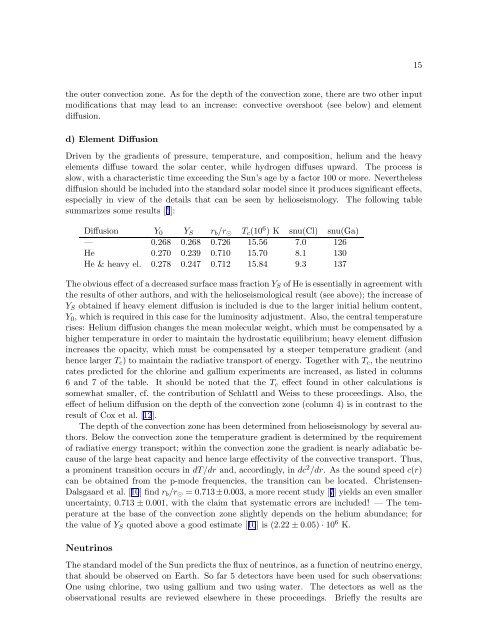Proc. Neutrino Astrophysics - MPP Theory Group
Proc. Neutrino Astrophysics - MPP Theory Group
Proc. Neutrino Astrophysics - MPP Theory Group
You also want an ePaper? Increase the reach of your titles
YUMPU automatically turns print PDFs into web optimized ePapers that Google loves.
the outer convection zone. As for the depth of the convection zone, there are two other input<br />
modifications that may lead to an increase: convective overshoot (see below) and element<br />
diffusion.<br />
d) Element Diffusion<br />
Driven by the gradients of pressure, temperature, and composition, helium and the heavy<br />
elements diffuse toward the solar center, while hydrogen diffuses upward. The process is<br />
slow, with a characteristic time exceeding the Sun’s age by a factor 100 or more. Nevertheless<br />
diffusion should be included into the standard solar model since it produces significant effects,<br />
especially in view of the details that can be seen by helioseismology. The following table<br />
summarizes some results [5]:<br />
Diffusion Y0 YS rb/r⊙ Tc(10 6 ) K snu(Cl) snu(Ga)<br />
— 0.268 0.268 0.726 15.56 7.0 126<br />
He 0.270 0.239 0.710 15.70 8.1 130<br />
He & heavy el. 0.278 0.247 0.712 15.84 9.3 137<br />
The obvious effect of a decreased surface mass fraction YS of He is essentially in agreement with<br />
the results of other authors, and with the helioseismological result (see above); the increase of<br />
YS obtained if heavy element diffusion is included is due to the larger initial helium content,<br />
Y0, which is required in this case for the luminosity adjustment. Also, the central temperature<br />
rises: Helium diffusion changes the mean molecular weight, which must be compensated by a<br />
higher temperature in order to maintain the hydrostatic equilibrium; heavy element diffusion<br />
increases the opacity, which must be compensated by a steeper temperature gradient (and<br />
hence larger Tc) to maintain the radiative transport of energy. Together with Tc, the neutrino<br />
rates predicted for the chlorine and gallium experiments are increased, as listed in columns<br />
6 and 7 of the table. It should be noted that the Tc effect found in other calculations is<br />
somewhat smaller, cf. the contribution of Schlattl and Weiss to these proceedings. Also, the<br />
effect of helium diffusion on the depth of the convection zone (column 4) is in contrast to the<br />
result of Cox et al. [12].<br />
The depth of the convection zone has been determined from helioseismology by several authors.<br />
Below the convection zone the temperature gradient is determined by the requirement<br />
of radiative energy transport; within the convection zone the gradient is nearly adiabatic because<br />
of the large heat capacity and hence large effectivity of the convective transport. Thus,<br />
a prominent transition occurs in dT/dr and, accordingly, in dc 2 /dr. As the sound speed c(r)<br />
can be obtained from the p-mode frequencies, the transition can be located. Christensen-<br />
Dalsgaard et al. [10] find rb/r⊙ = 0.713±0.003, a more recent study [7] yields an even smaller<br />
uncertainty, 0.713 ± 0.001, with the claim that systematic errors are included! — The temperature<br />
at the base of the convection zone slightly depends on the helium abundance; for<br />
the value of YS quoted above a good estimate [10] is (2.22 ± 0.05) · 10 6 K.<br />
<strong>Neutrino</strong>s<br />
The standard model of the Sun predicts the flux of neutrinos, as a function of neutrino energy,<br />
that should be observed on Earth. So far 5 detectors have been used for such observations:<br />
One using chlorine, two using gallium and two using water. The detectors as well as the<br />
observational results are reviewed elsewhere in these proceedings. Briefly the results are<br />
15













